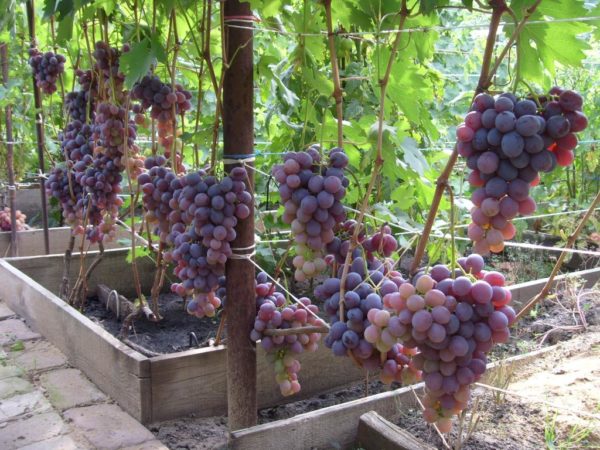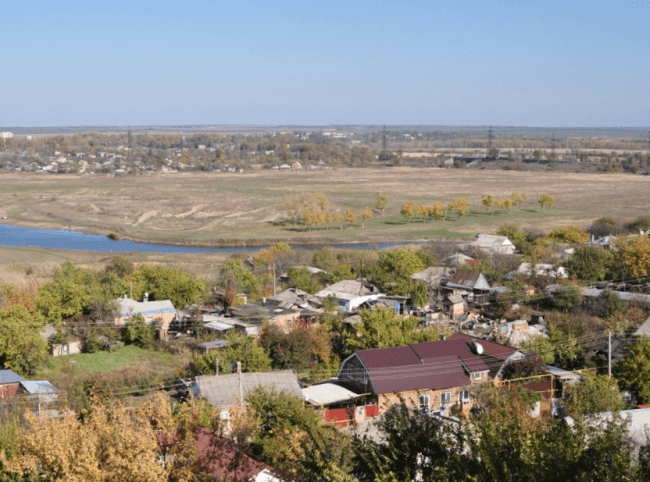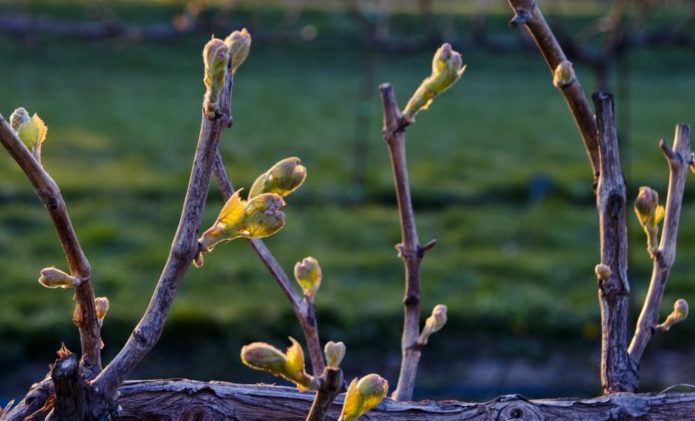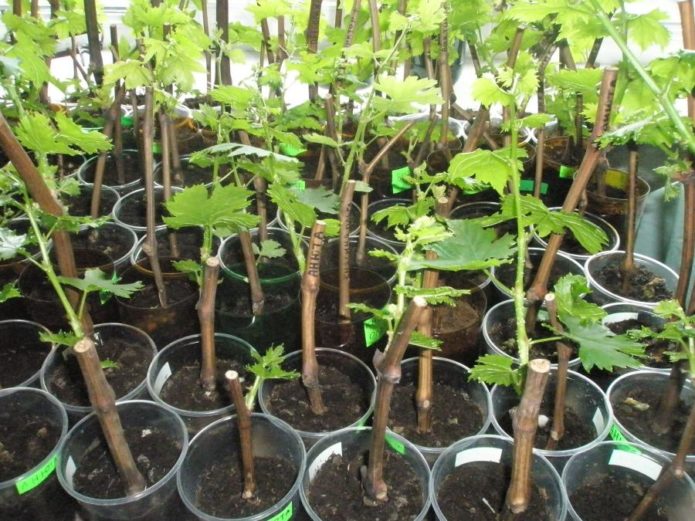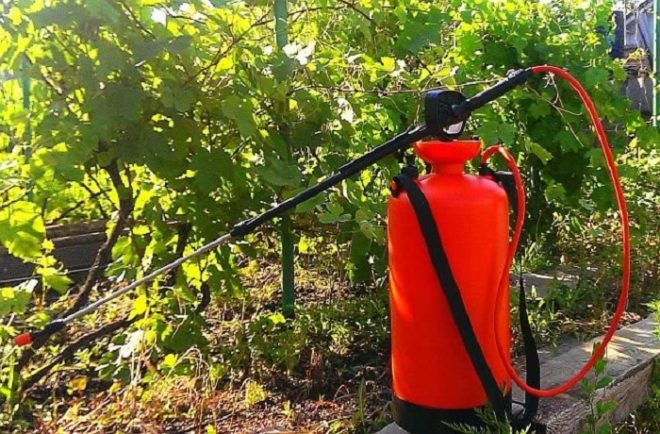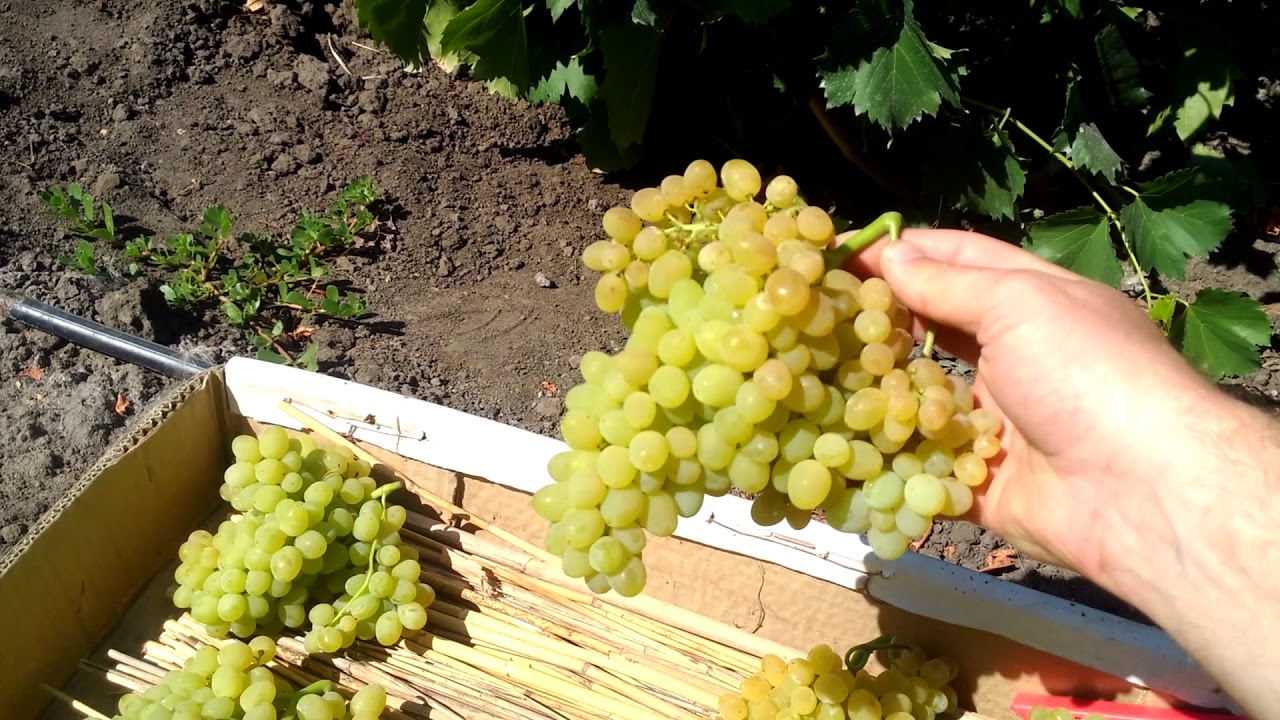The Nizin hybrid will be of interest to those looking for grapes with powerful vines, large bunches and table berries. The variety is popular among farmers and is found in industrial plantings. They say that the Lowland is profitable at any market price, it is so fruitful. Of course, the greater vigor of the bushes must be maintained and guided. A huge plus of the Lowlands is that it bears fruit perfectly in all regions of Russia, except for the Far North.
Content
History of the Nizin grapes
The creator of the Lowland, V.N.Krainov, is no longer alive, but people are talking about him more and more often. More and more space in private gardens and industrial vineyards is occupied by hybrid forms of its selection. Moreover, these grape varieties were bred not at the experimental station and not in the laboratory of the research institute, but in the ordinary garden plot of Novocherkassk by a simple grape lover. Today, the best three of Krainov are called hybrids: Victor, Transfiguration and Anniversary of Novocherkassk. Lowland was one of the first works of a self-taught breeder and very successful.
Already in 1998, some hybrid seedlings threw out the inflorescences and bloomed, in August - September the first harvest of new forms of grapes was obtained, among which the almost legendary hybrid form of Nizina was distinguished.
In one of his last interviews, taken in 2009, Krainov himself spoke about the origin of the Lowland and other forms. He became interested in growing grapes at the age of 15, his father instilled an interest in this culture. In 1986, Viktor Krainov acquired his own plot of land on the banks of the Tuzlov River. It is always colder by the river, the air is damp, there are often recurrent frosts, there are fogs and abundant dew falls. Of course, in such conditions, only grapes that are resistant to diseases and cracking of berries could grow. This explains the popularity of Krainov's hybrids - almost any climatic conditions for them will turn out to be just paradise.
On the advice of a scientist who worked at VNIIViV them. Potapenko, I.A.Kostrikina, in 1995/96. Krainov carried out the first crosses. One of the versions of the origin of the name Nizin - the word is made up of the names of Nina and Zina, that was the name of the wives of Krainov and Kostrikin. Although another option is no less logical and beautiful: the first hybrid obtained by the gardener is named for its place of origin - in the lowland, by the river.
For crossing grapes were used Talisman + Tomaysky, Talisman + Autumn black and Talisman + Radiant raisins. Hybrid forms of grapes from seeds obtained as a result of these crosses confirmed the correct choice of pairs of grape varieties to obtain new hybrid forms.
From which pair Nizina was obtained, Krainov does not specify in an interview, but says that already 2 years after sowing the seeds, he received the first bunches of berries. It took much more time to identify the best forms among the seedlings. So, in 1998 Nizina appeared, followed by Blagovest, Nina, Tuzlovsky giant, etc. A total of 45 hybrids were bred, many of them received "permanent registration" in the garden plots of winegrowers and pressed other varieties on the market.
Video: V.N.Krainov introduces new forms of grapes on his site
Description of the Nizina variety
The hybrid is called mid-early, because 120-135 days pass from budding to ripening. This period depends on the amount of heat that the summer will give. Spring comes in Russian regions at different times. In the south, buds can bloom in April and even March, and in the middle lane and Siberia - in May. Therefore, the Lowland harvest is ready to be harvested at different times: from mid-August to late September.
The Bunch of the Lowlands is very large, cylindrical, tapering downward. According to the State Register, it weighs about 700 g, but the growers speak of an average weight of 1 kg, and on especially fruitful bushes, clusters of 2-3 kg grow. The total weight of berries from one plant also depends on the growing region. Up to 20 cysts are harvested from 3-4-year-old bushes in the middle lane, and, for example, in Ukraine - 60 brushes, two on each shoot. As a result, the yield reaches 14–45 kg or more.
Video: harvesting from a 3-year-old bush, weighing bunches
Berries of the Lowland are large - up to 5 cm in diameter, weighing 15–20 g each, loosely located in the cluster. Painted in red-violet color, they appear transparent in the sun. Inside there are 2-3 seeds and fleshy flesh, the skin is not felt when eaten. In taste and aroma, this grape reminds many of cherries, there is a slight sourness. The main reason for negative reviews about the Lowland is the early harvest due to its deceptive appearance. The berries are colored two weeks before ripening, that is, they already look appetizing, you want to pick and eat, but you haven't accumulated sugar yet. Holders of the Lowlands need to be aware of this feature and not draw conclusions about taste ahead of time.
This Krainov form has other differences. The vines grow vigorous, about 1 cm thick. The leaves are medium-sized, five-lobed, strongly dissected. Annual shoots during the season manage to pour the bunches and fully ripen (woody) a meter in length and more. High vitality is also manifested during reproduction: the cuttings of the Lowlands take root quickly, the seedlings take root easily.
Advantages and disadvantages of Nizina grapes (table)
| Benefits | disadvantages |
| High yield | Average disease resistance - by 3 points, affected by powdery mildew |
| Presentation of berries | Dining room, not used in winemaking |
| Taste and aroma of grapes with fruity notes, moderately sweet | A powerful bush requires a lot of space on the site |
| Vines ripen well over the summer | Rationing of the harvest |
| Fruitfulness of shoots - 80% | The rates of fertilizing and watering are higher than for bushes with medium and weak growth |
| Berries do not crack even during the ripening period after showers | |
| Almost not affected by wasps | |
| Grapes are well transported and stored (until December) | |
| Withstands frosts down to -23 ⁰C |
Video: overview of grapes Nizin
Feature of planting seedlings Lowland
Of course, you need to choose the sunniest site for the vineyard. It is advisable to protect it from the wind, heavy bunches of the Lowland should not sway from its gusts. The hybrid develops not only powerful shoots, but also a voluminous root system. If on your site the groundwater level is less than 2.5 m from the surface, then you will have to make a mound for the grapes or plant it on natural hills.Otherwise, the roots, reaching the aquifers, will begin to rot, the bush will stop growing and wither.
The timing of planting is usually dictated by the market: when seedlings appear, then you have to plant. Planting is traditionally done in spring in almost all regions. But if there is a choice, then it is better to plant grapes in the middle lane and Siberia in the spring, and in the south - in the fall. It is advisable to buy dormant seedlings without leaves, that is, in the spring they have not bloomed yet, and in the fall they have already flown. Seedlings in containers with a closed root system can be transplanted by transshipment from spring to autumn.
Planting pattern for Lowland: 3 meters in a row and 4 meters between rows. Dig the planting holes and fill them with nutritious soil mixture at least 2-3 weeks in advance, so that the earth has time to sink, and all the components in it can mix and interact.
Stages of planting grapes Nizin:
- Dig holes 80 cm deep and in diameter. Place the soil from the upper 30 cm next to the hole, and remove the lower infertile layer from the site. It cannot be used for planting.
- Lay drainage at the bottom with a layer of 10-15 cm. Broken brick, expanded clay, etc. will do.
- On top of the drain, lay a layer of the same thickness of plant residues: fallen leaves, grass, pieces of bark, small twigs.
- Pour 3-4 buckets of humus or compost on top.
- Mix the soil of the top layer with 200 g of superphosphate and 150 g of potassium sulfate, you can replace 1 kg of wood ash.
- Fill the hole to the top with the mixture. If it is not enough, then the top layer can be made from ordinary soil from the site.
- Water the seedlings well one day before planting, and with open roots put them in water with root formation stimulants, for example, Zircon, Epin, Heteroauxin, etc.
- On the day of planting in the pits, make holes the size of the roots of the seedlings and spill them well with warm water or a solution with a growth stimulator.
- Place the seedlings in the holes, spread the roots and cover with earth. It can be deepened to the first branch on the trunk, then it will be convenient to bend the vines and cover them for the winter.
- Water the wells and mulch.
The pits are made large and well fertilized to give the Lowland bushes a good start. This nutrition for an aggressively growing hybrid should be enough for two years, before entering into fruiting, and then it is time for top dressing.
Video: lazy planting of grapes on clay soil "under the drill"
Features of lowland care
There is no need to pour the grapes, even in the first year after planting. For one bush, it is enough to spend 2-3 buckets of water every 3-4 weeks and then in the absence of rain. Irrigation rates for the fruiting Lowlands are 40–70 liters per plant. Depends on the structure of the soil: clay absorbs less water, sandy - more.
Important periods when grapes need irrigation:
- in spring, during the growth of leaves and shoots; do not water if frost is expected at night;
- during the budding period;
- at the beginning of the growth of berries, they should be the size of a pea.
Stop watering when the clusters and berries have reached their size, begin to color and ripen. If it rains at this time, it is advisable to install canopies made of waterproof materials over the vines.

Despite the wide range of modern fertilizers, humus or compost remains the most popular and effective top dressing.
Apply the main top dressing in the fall, after harvesting. Scatter 2-3 buckets of humus and 0.5 liters of ash under each bush. Better to make an annular groove 25 cm deep, stepping back from the base of the bush 50 cm. Spread fertilizer evenly, water and level. Do all other fertilizing at the same time as watering, combine with them. Use infusions: mullein (1:10), bird droppings (1:20), nettle (1: 5). 3-4 days after these dressings, dust the ground with wood ash and loosen, mixing it with the ground.
To combat fungal diseases, use fungicides: Skor, HOM, Bordeaux liquid, etc. Spray in spring and autumn, you can repeat treatments at intervals of 10 days. The frequency and frequency depends on the weather conditions and how badly the grapes were sick last summer. For prevention, 1-2 treatments per season are enough. And if there was a strong defeat last year, the weather is rainy, then more thorough protection is needed: spray before and after bud break, immediately after flowering and after harvest.
Video: Forming grapes in 4 sleeves
Nizin grapes are formed into 2–4 sleeves. The total number of buds on vines should be in the range of 20–35 pcs. In the regions of risky farming, they are left less, for example, growing in 2 arms with 8-10 eyes on each. In the south, a 4-arm shape with 5-8 eyes on each vine is practiced. On each shoot of this hybrid, 1-2 brushes are laid. If the summer is cool and short, then you need to do normalization, leaving one at a time on the shoot.
In autumn, in regions with extreme winters: frosty, little snow, with freezing rains, the shoots of the Lowland should be laid on the ground and covered. For this, use spruce branches, agrofibre, reeds, sheets of cardboard and other insulation. Arrange a waterproof layer on top, for example, from a film or roofing material.
Harvesting and application of the crop
The berries of the Lowland do not have the famous nutmeg shades that are so prized in winemaking, but they have a pronounced fruity taste, which is a great rarity for grapes. The main purpose of the hybrid is fresh consumption. Many farmers include Lowland in their collection for the market.
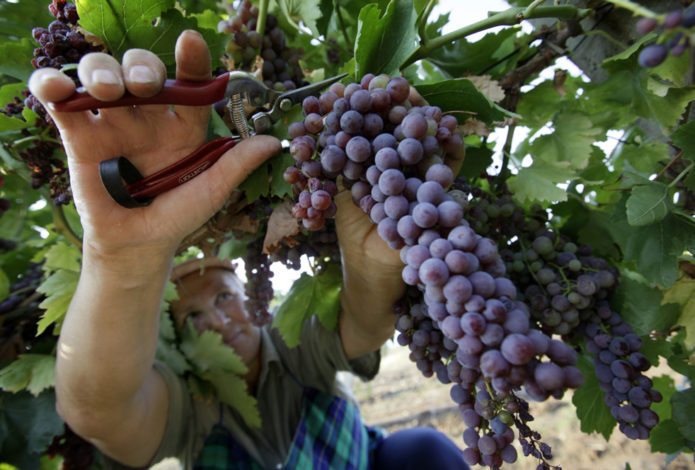
To preserve the presentation and extend the shelf life, during harvest, hold the bunch not by the berries, but by the leg
If you plan to store, transport, sell grapes, cut the bunches carefully. Choose for this the first half of the day, when the berries have already dried out from dew, but have not yet warmed up in the sun. When collecting, try not to damage the wax coating on the skin. Hold the brushes by the twigs and place them in boxes lined with paper. At a temperature of 0 ... +7 ⁰C Nizin grapes are stored for 2 months, but they must be regularly checked and sorted, removing rotten berries. Surplus crops are frozen, processed into compote or jam.
Reviews about grapes Nizina
Eaten the last brush of the Lowlands today. Acid and sugar in an excellent balance, when, like a couple of weeks ago, it soured (mowed like a cherry) when it was quite marketable. The family appreciated the taste and appearance, but the time frame was not very good. Nevertheless, the verdict is to be on my collection. There are just a few bushes in the marketable planting, five bushes.
Last year, my Lowland had its first fruiting and it ripened in early September. This year, ripening was delayed and ripened almost a month later than last year, the overload affected wanted to leave 25 kg for a three-year-old bush, but when I weighed an average bunch and counted it turned out to be about 40 kg. - there was clearly a lot for a three-year-old bush, and it was thickened, the growth of shoots powerful and in early September picked up oidium.
I have the first fruiting in the lowlands (last year). 4 bunches were left (see photo). as it turned out, more could have been left. the growth force under this load is very high, the ripening of the vine is up to 3 meters. I liked the taste very much, unusual with sourness. ripened (in my conditions) in early September (along with the talisman).
About GF Nizina. In the summer of 2012 I had the first fruiting of GF Nizina and Nina. The bushes are nearby, it is easy to compare. The bushes are 3 years old, self-rooted, planted with vegetative seedlings from cuttings from Shpak V.A. The growth force of the bushes is large. Pollination and the formation of bunches in Both GFs went well, there were no peas. The shapes are very similar, although there are differences. The bunches at the Lowland were larger,up to 0.7-1.2 kg, colored ten days earlier, and ripened a week later than Nina. The color of Nina's berries were brighter light purple, and the Lowlands were saturated dark purple. Nina's bunches were denser. There was no cod of berries , rot too, wasps and hornets (there were a lot this summer) did not touch. The taste of the berries is about the same, Nina's sweeter ones were cut in two runs from September 15 to 25. Nizina ripened for another 10 days (they took them to the wedding, there were very beautiful) although, for my taste, a little sour. Judging by the flowering of the Lowland, it is very fruitful gf, more than Nina.In our region, the Lowland must be carefully rationed and it is better to underload, maybe the underload will accelerate ripening and improve the taste of the berry. With 3-fold processing (copper oxychloride-crydomil gold-quadris), the vines did not hurt, ticks were not noticed. The vine ripened well. I also noticed that the stepson formation of the vines is not great. Judging by the first fruiting, there are still more advantages for me. I will work with these gf further.
The lowland stands out among many hybrids and varieties for its great vigor. It should be borne in mind that powerful bushes will take up a lot of space in the garden. Almost every shoot is fruitful, tying 1-2 bunches. In inept hands, this plus turns into a minus. The vines are overloaded; in a cool or short summer, the berries do not ripen. Therefore, it is important to form bushes in accordance with their age and climatic conditions, as well as to carry out rationing of the yield.
